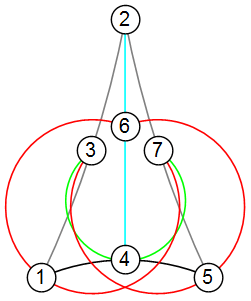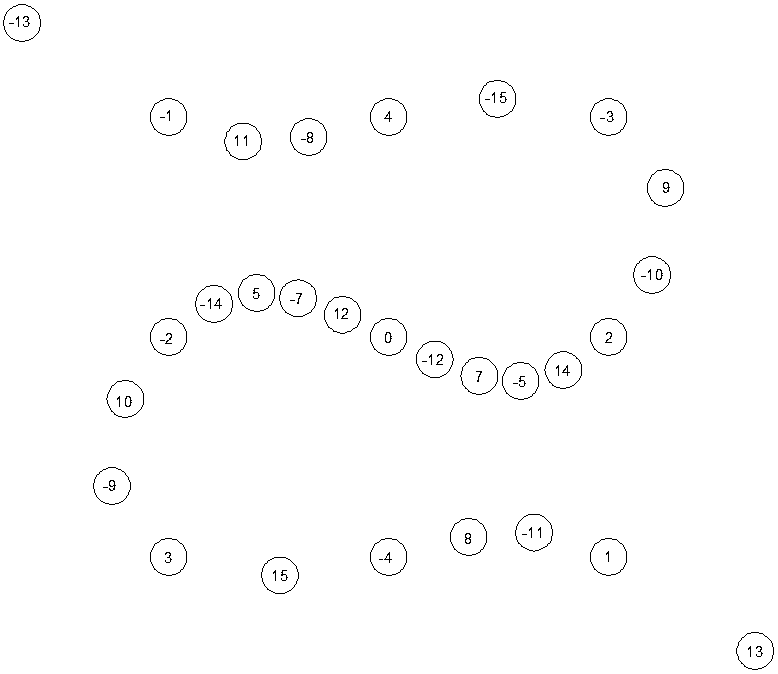You might be familiar with the Fano plane. One way to obtain it is to select triples from 1 to 7 that have a binary bit sum of 0. It's an example of a projective plane.
Projective plane rules
- Every point pair defines a line.
- Every line pair defines a point.
- There are 4 points not on a line.
Code:
Select[Subsets[Range[7], {3}], BitXor @@ # == 0 &]
These can be arranged so that each triplet (123 145 167 246 257 347 356) is on an arc or a line.

So how to draw a bunch of nice arcs and lines? Here's some code I whipped up.
ArcDraw2D[{threepoints_}] :=
Module[{colinearitytest, circle, center, radius, angles, ends},
colinearitytest = Chop[N[Det[Append[#, 1] & /@ threepoints]]];
If[colinearitytest != 0,
circle = Circumsphere[threepoints];
center = N[circle[[1]]]; radius = N[circle[[2]]];
angles = Mod[N[Arg[(# - center).{1, I}]/Pi], 2] & /@ threepoints;
ends = {angles[[1]], angles[[3]]};
If[angles == Sort[angles] || angles == Reverse[Sort[angles]],
Circle[center, radius, Pi ends],
Circle[center, radius, Pi {Max[ends], 2 + Min[ends]}]],
Line[threepoints]]];
Now, let's extend that. Select[Subsets[Range[15], {3}], BitXor @@ # == 0 &] gives the next step up: triples from 1-15 with a BitXor sum of 0. I'll rearrange the output a bit.
pg23 = {{1, 4, 5}, {8, 9, 1}, {2, 10, 8}, {14, 12, 2}, {5, 11, 14},
{1, 3, 2}, {2, 7, 5}, {5, 13, 8}, {8, 6, 14}, {14, 15, 1},
{2, 6, 4}, {14, 7, 9}, {5, 15, 10}, {1, 13, 12}, {8, 3, 11},
{6, 11, 13}, {7, 4, 3}, {15, 9, 6}, {13, 10, 7}, {3, 12, 15},
{15, 8, 7}, {13, 2, 15}, {3, 14, 13}, {6, 5, 3}, {7, 1, 6},
{9, 3, 10}, {10, 6, 12}, {12, 7, 11}, {11, 15, 4}, {4, 13, 9},
{9, 2, 11}, {10, 14, 4}, {12, 5, 9}, {11, 1, 10}, {4, 8, 12}};
Now a bit of set-up for the graphic.
numbers = {8, 2, 14, 5, 1, 3, 6, 7, 15, 13, 11, 4, 9, 10, 12};
locations = Flatten[MapIndexed[
RootReduce[{Sin[2 (#2[[2]] - 2) Pi/5],
Cos[2 (#2[[2]] - 2) Pi/5]} {2, .5, -1.378}[[#2[[1]]]]] &,
Partition[numbers, 5], {2}], 1];
newloc = Last /@ Sort[Transpose[{numbers, locations}]];
colors = {Black, Gray, Cyan, Green, Red, Yellow, Blue};
Then we can go right to the graphic.
Graphics[{AbsoluteThickness[1.6],
MapIndexed[{colors[[Ceiling[#2[[1]]/5]]], ArcDraw2D[newloc[[#1]]]} &, pg23],
MapIndexed[{{Black, Disk[#1, .12]}, {White, Disk[#1, .11]},
Style[Text[#2[[1]], #1], 20]} &, newloc]},
ImageSize -> {500, 500}]

If you look close, you can see the Fano plane from the opener in here. There are 15 Fano planes of 3 different types. To see these in 3D, take a look at 15 Point Projective Space.
An alternative geometry allows lines that don't intersect, otherwise known as parallel lines.
Affine plane rules
- Every point pair defines a line.
- Every point-line pair defines a line.
- There are 4 points that define 6 lines.
One affine plane example is the Game of Set, where each of 81 card has three possibilities for the attributes number, color, shape, and shading. In a line of three Set cards, the values for a given attribute will be either all the same or all different. There are 1080 ways to get a Set triplet.
Select[Subsets[Range[1, 81], {3}], Total[Mod[Total[IntegerDigits[#, 3, 4]], 3]] == 0 &]
Is there another nice affine plane where all lines have 3 points? Yes, within elliptic curves. Take triplets from the integers that add to zero. Now place them on the plane so that all triplets are on a straight line. You might get an image like the following:

If you pick any triplet with a sum of 0, you'll find it is on a straight line. To add new numbers, pick two pairs with the opposing sum, such as {1-,-15} and {-2,-14} for 16. The new number will go to the intersection point of the two lines.